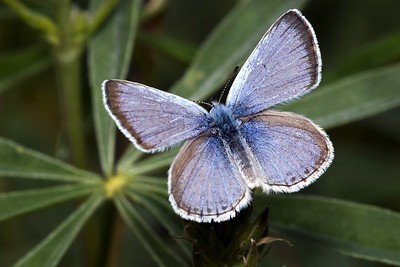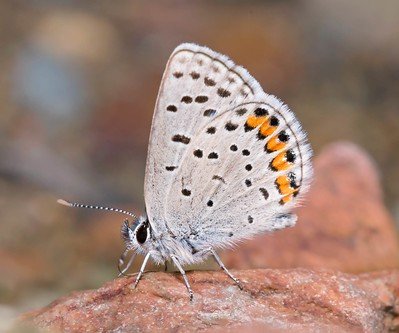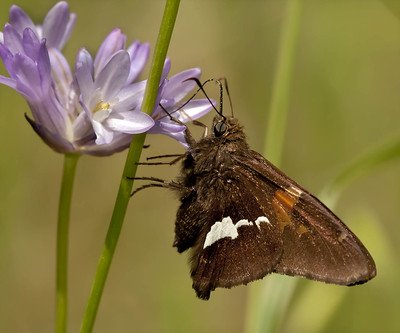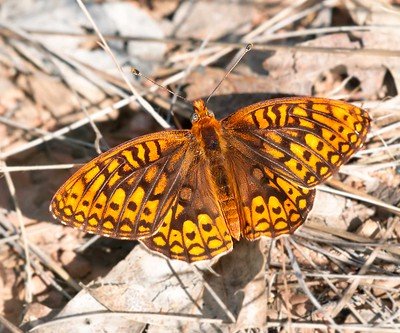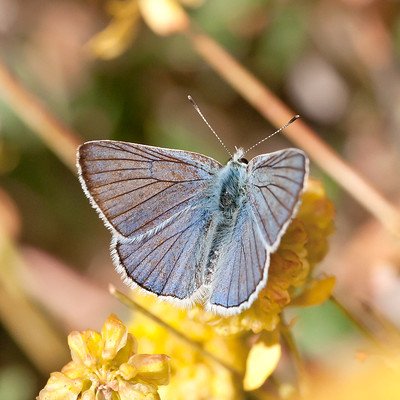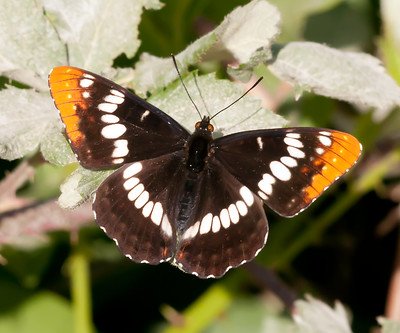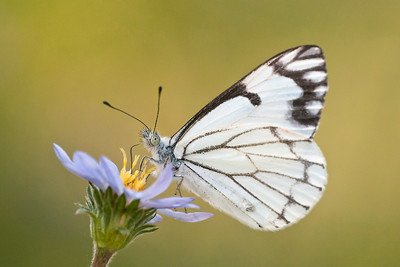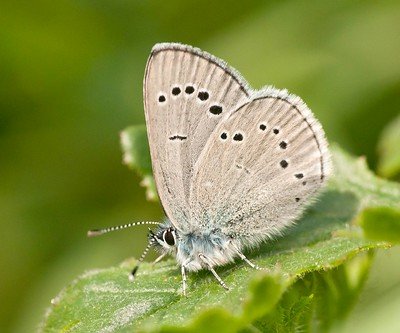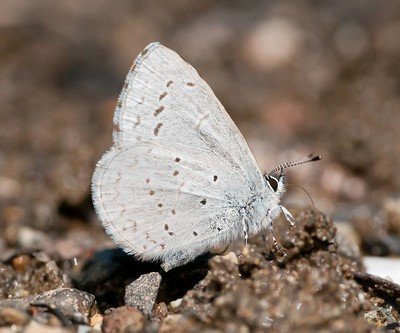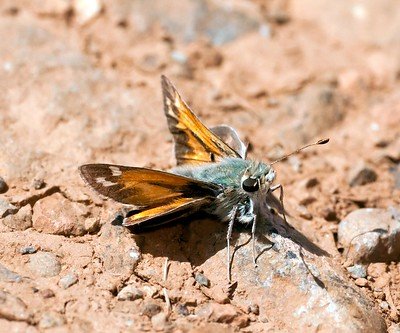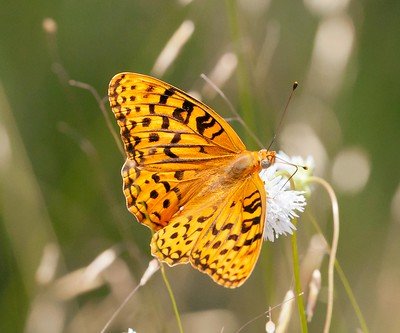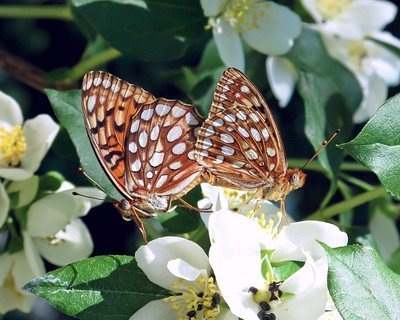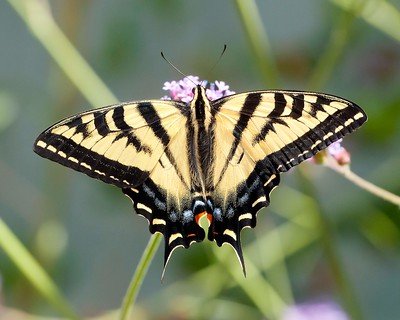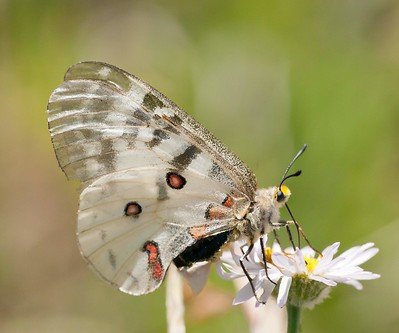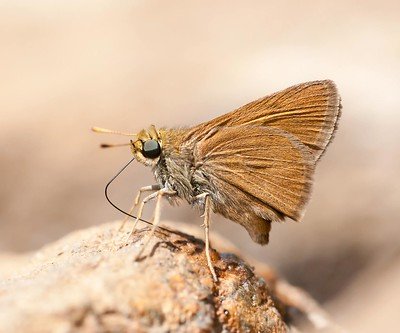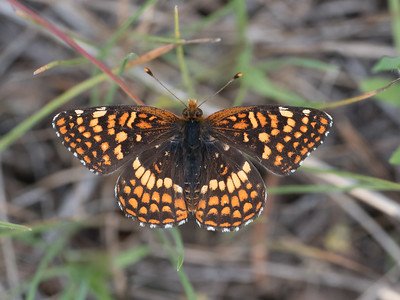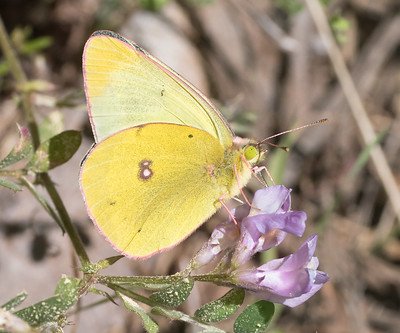Chasing butterflies and restoring their food: my internship with Vesper Meadow 2022
A summer internship spent conducting Butterfly Surveys and supporting Pollinator Habitat Restoration with Vesper Meadow
by Cecilia Green, Summer Intern 2022
A sampling of butterflies surveyed this year on our Pollard walk surveys at Vesper Meadow. Pictures by Rob Santry.
Frittilary in the pollinator patch at Vesper Meadow. photo by Barbara Rumer
Check out the Vesper Meadow Butterfly ID guide brochure to start learning about butterflies.
Butterflies are an important part of a functioning ecosystem like bumble bees, butterflies are also pollinators. Native wildflowers and plants depend on native butterflies for pollination, so that they may reproduce. Oftentimes butterflies evolve with a single host plant which provides their eggs a resting place, and allows their larvae or caterpillars to eat the nutrients they need to transform into butterflies. For example fritillaries use violets as a host plant and no other plant will do, if violets ceased to exist so too would fritillaries. Or Tiger Swallowtails lay their eggs on willow which is actively planted through creek restoration within the Vesper Meadows Restoration Preserve. Researchers, and volunteers use ecological restoration techniques to create an environment which will allow these creatures to flourish and ensure their return annually through the planting of native plants, and seed collection.
To accurately document the species of butterflies within the meadow a pollard walk protocol is used. Pollard walks are 1 km transects divided into five sections which are 200 meters each, A, B, C, D, E. Researchers walk slowly along the transect using butterfly nets to capture and identify butterflies, including those seen on the wing (butterflies flying by). This is the same protocol used by the Cascade Siskiyou National Monument, which consists of 114,000 acres of protected wilderness neighboring the meadow. Pollard walks are conducted bi-weekly in the spring and summer months, surveys must be conducted when temperatures are 70 degrees or higher with clear skies, and 10 mph winds or less for optimal butterfly activity. This is because butterflies tend to hide when the weather is too cold or the wind is too strong for them to fly. Vesper Meadows currently has 3 transects that are being monitored by researchers. Each transect crosses through a variety of terrains, from meadows to forests, up hills and across streams.
Vanessa Keck, our Butterfly Research Intern 2021 works together with Cecilia to conduct an early season butterfly survey in June 2022.
Butterfly data is collected by researchers and uploaded to Pollard Base, an online database which compiles butterfly sightings across the nation. With this data scientists can determine the flight time for butterflies in different locales, it also tracks population densities and trends. This data is a useful tool for restoration, allowing ecologists to identify host and pollinator plants for future seeding to encourage butterfly reproductivity. This data also acts as a warning system because a decline in population trends can reveal damages made to the environment.
Native pollinator gardens are a useful tool for attracting butterflies and creating habitat for them to lay their eggs. The flowers that dominate the meadow include, prairie smoke, elephant head, tar weed, oregon sunshine, seablush, camas, mules ear, flax, yarrow, penstemon, cinquefoil, coyote mint, horsemint, trilliums, buttercups, bistort, lupine, fiddleheads and much more. With an abundance of plants and flowers it is no wonder that this meadow is a hotspot for butterfly biodiversity.
Butterflies and insects are facing a global decline due to the effects of climate change, global warming, pesticide use, habitat alteration, and decreasing connectivity. This month the Monarch butterfly was officially declared endangered, it is unclear what the future holds for these beloved creatures. Education and awareness is the best tool we can utilize as a community to prevent the decline of pollinators. Without insects the world's crops will not be pollinated leading to increased food shortages across the globe. Wild insects pollinate crops more efficiently than honey bees, over the last 120 years wild bee and insect populations have drastically decreased. Changing weather patterns and increased temperatures has serious implications for the wild insect population, and as a result serious consequences for humanity.
Further resources
If you want to learn more about butterflies there are some great resources in Southern Oregon to join butterfly walks and counts. Check out this beautiful brochure of 80 local butterfly species to get started with butterfly identification:
Join our mailing list to hear about events that will help you learn about and ways to support native pollinators and butterflies. The Siskiyou Field institute also offers butterfly classes with local experts, upcoming classes can be found www.siskiyoufieldinstitue.org. The Pollinator Project Rogue Valley offers events, and educational opportunities to learn about the importance of pollinators. You can check out their website for news and events at www.pollinatorprojectroguevalley.org.
If you are interested to purchase native plant seeds for your yard, join a community of folks working to increase native plants in southwest Oregon, or learn more about cultivating native plants, join the Rogue Native Plant Partnership email list.
“Vesper Meadow has been a place of healing, beauty, and learning for me. I never realized the impact that it would leave on my soul until spending time with the land. I have developed a lifelong connection to this place, and an ever-growing desire to be a steward of the land. By caring for the land, I will ensure its health for others to enjoy for generations to come. I can be an ally to the indigenous peoples of this land and the surrounding community through restoration, art, sciences, and education. The relationships I have formed here are invaluable and I am grateful every day for the time I have spent here. ”

